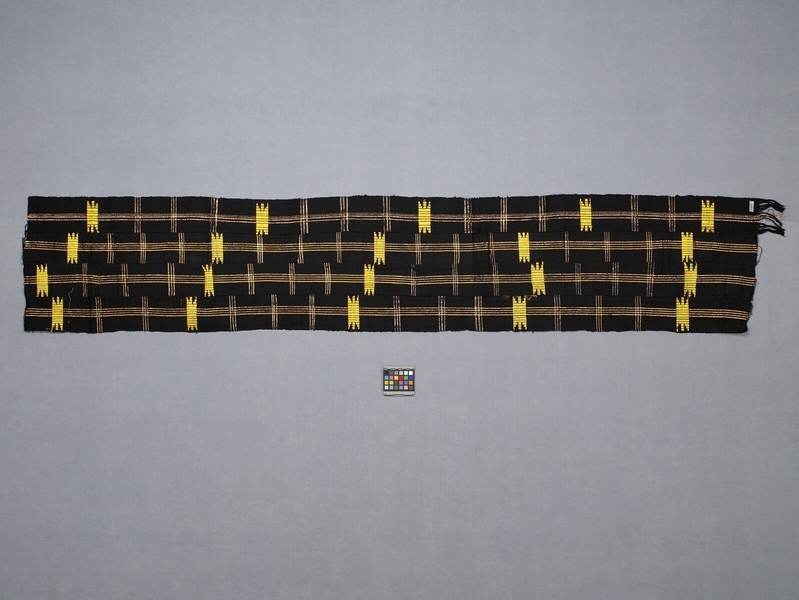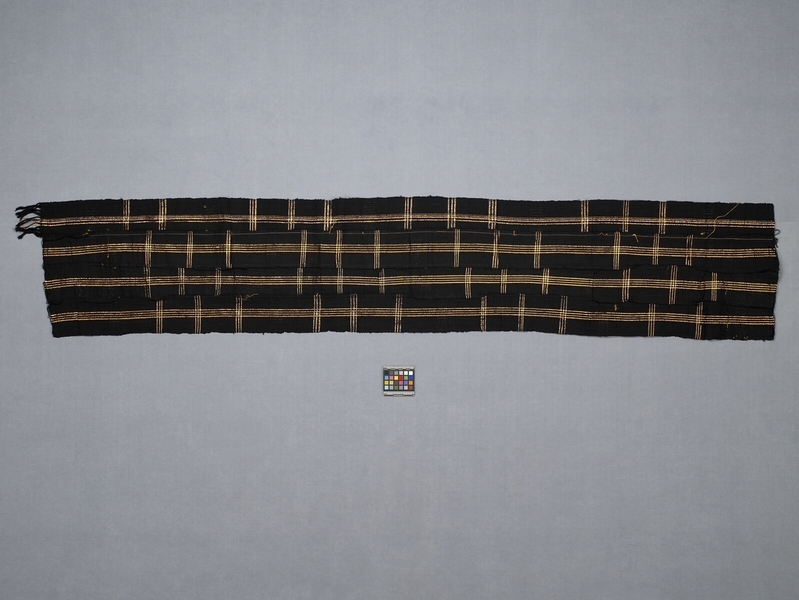Head Scarf Item Number: Af456 c from the MOA: University of British Columbia


Description
Head-tie that together with a blouse (Af456 a) and a skirt (Af456 b) forms a costume or a suit. The tie is a rectangular length of fabric consisting of four strips of black cotton sewn together. Both warp and weft have gold metallic stripes; supplementary weft floats of gold silk in solid linear design occur at regular intervals within each strip, but occur randomly in the overall pattern. Ends are unfinished and unstitched between three of the strips.
History Of Use
Aso-òkè head scarf. The strips are normally woven by men on a belt loom. Weaving is concentrated in a few centres, and the weavers are full time specialists. The supplementary weft floats are common in Yoruba textiles. The clothing would be sewn together by women. Aso-oke was used for everyday use, and traditional and religious occasions. Generally, aso-oke is classified into three main types: etu, alaari, and sanyan. They are identified by their pattern- achieved through extra weft brocading technique- and colour, as well as their use for designated traditional ceremonies. Aso-oke use was impacted by British colonization as economic policies implemented then favored the influx of foreign goods, especially British cotton manufactured goods at the expense of indigenous traditional textiles industries. Mass-produced English-style cotton garments, and the introduction of foreign yarn, competed with hand crafted aso-oke leading to decline in patronage and production, evident by the early 1900s. The introduction of Islam and Christianity to Yorubaland also introduced new dress styles for converts, affecting the popularity of aso-oke. British garments were largely seen as markers of prestige, innovation and civility over indigenous clothing. However, the struggle for independence leading up to 1960 ushered in a wave of cultural nationalism, leading major ethnic groups to dress in garments particular to their region. Aso-oke can be found in markets today and is still worn at special occasions, such as weddings, birthdays and burial ceremonies around the world.
Iconographic Meaning
Aso-oke is also known to symbolize protection, especially from spiritual problems. It is used as a sacred cloth by a cult called the Ogboni society, as a covering for religious objects, and is said to be prescribed by traditional priests as a choice of attire for wedding ceremonies to guarantee the success of a marriage.
Item History
- Made in Ibadan, Nigeria before 1972
- Collected during 1972
- Owned by Andrew Stewart and Jessie Stewart before February 8, 1980
- Received from Andrew Stewart (Donor) and Jessie Stewart (Donor) on February 8, 1980
What
- Name
- Head Scarf
- Identification Number
- Af456 c
- Type of Item
- scarf
- Material
- cotton fibre, metal, silk fibre and dye
- Manufacturing Technique
- woven and stitched
- Overall
- height 195.5 cm, width 35.8 cm
Who
- Culture
- Yoruba
- Previous Owner
- Andrew Stewart and Jessie Stewart
- Received from
- Andrew Stewart (Donor) and Jessie Stewart (Donor)
Where
- Holding Institution
- MOA: University of British Columbia
- Made in
- Ibadan, Nigeria
When
- Creation Date
- before 1972
- Collection Date
- during 1972
- Ownership Date
- before February 8, 1980
- Acquisition Date
- on February 8, 1980
Other
- Item Classes
- textiles
- Condition
- good
- Accession Number
- 0590/0123 c